
|
Natural Threats
Turtles of the size range found on the Bermuda Platform have only one natural enemy sharks. Small post-hatchlings found out in the Sargasso Sea are threatened by a wider range of predators including fish and several species of birds. Eggs and hatchlings on nesting beaches face
predation by ants, crabs, birds and dogs on land, and the hatchlings face a host of marine carnivores such as snappers, groupers, barracudas and sharks once they reach the sea. Nests are also lost to erosion of the nesting beach.
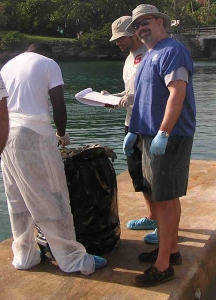 Learning from sea turtle necropsies. Learning from sea turtle necropsies.
Threats to sea turtles in Bermuda are documented by a Stranding Network at BAMZ that receives stranded turtles from the public in Bermuda. Some of these turtles can be saved and returned to the wild (see section on Rehabilition). However, information on the cause of death of some of the animals that don't survive can be gained during necropsies. Each year, as part of the Bermuda Turtle Project's annual course, sea turtles that have died from a variety of causes are necropsied under the direction of Dr. Ian Walker, the Director of BAMZ (pictured at right). The examples discussed below have been observed during these necropsies.
Human-Caused Threats
Although sea turtles are strongly protected in Bermuda
waters, they still experience many negative impacts from humans.
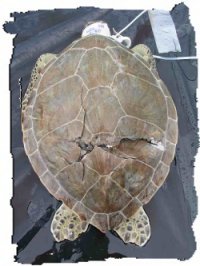
|
- Boat Collisions
The sea turtles of Bermuda have for many years been exposed to ships and marine craft which abound along our shores. However, with increasing numbers of high-speed, high-powered watercraft, sea turtles have a much more difficult task to elude these vessels. A number of sea turtles are
killed in collisions with boats and many more are injured or maimed for life.
|
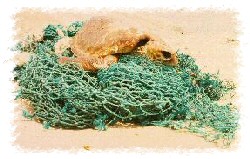
|
- By catch in commerical longlines
Loggerheads
and leatherbacks are vulnerable to mortality from longline fishing gear. They
swallow the baited hooks or become accidentally snagged by the dangling hooks.
Loggerheads have been found stranded
in Bermuda with the heavy long-line hooks and line still attached.
- Entanglement in Fishing Gear
Although there are no shrimp trawlers in Bermuda's territorial waters,
lost or discarded fishing nets and ropes are often washed up on our
shores. On occasion, sea turtles are washed ashore tangled in the rope
and twine that served as their death trap. Unable to free themselves
from such debris, their struggle to reach the ocean surface for a
breath of air fails, due to the weight of their burden, and this
results in drowning. In other cases, the turtle becomes so entangled
that it is unable to feed and it slowly starves to death.
|
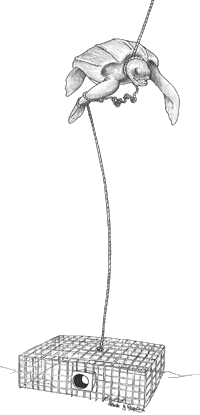
|
The practice of trap fishing in Bermuda and elsewhere has been identified as a threat
to the ocean-going leatherback turtle which occasionally comes near
shore. Through adaptations for speed and power in the open ocean, the
leatherback has lost the ability to swim backward which would allow it to extract itself from entrapment.
The leatherback is apparently attracted to
the buoys that mark fishing traps and regularly become
entangled in the attached line. With forward speed and power the only
means of escape, the turtle will swim in circles that can
result in a fatal entanglement.
- Entanglement in Recreational Fishing Gear
An increasing problem in Bermuda's territorial waters is entanglement
of marine turtles in monofilament. This line often
appears to have been discarded by recreational fishermen. Each
year several turtles are brought to the aquarium that have drowned or
been badly injured by discarded line. This is a problem that the
average Bermudian can help with. If you fish and your line
becomes entangled on the bottom, do everything you can to retreive the
hook and line. If you can't free the hook, try to get the line to
break at the hook or leader by pulling as hard as you can. Don't
cut the line at the reel and then let a long piece of line go
underwater.
|
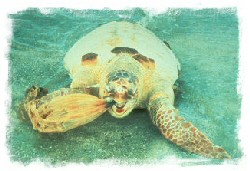
|
- Ocean Debris
Aserious threat to sea turtles is pollution and debris in our
oceans. Those forces that concentrate Sargassum and the post-hatchling
turtles that live in weedlines also concentrate marine debris and oil.
Epipelagic-size turtles that strand in Bermuda often have small
pieces of plastic in their digestive tracts that they undoubtedly
mistook for food. Also, species that feed on jellyfish often
mistake plastic bags for food. Ingestion of such trash can lead to
clogging of the digestive tract and death.
Young turtles in their pelagic phase are dependent on ocean driftlines
for food. It is at these driftlines that ocean debris accumulates.
Young turtles feeding there are known to ingest plastics, styrofoam,
balloons and tar. Tar is the result of weathering of oil at ocean
surfaces. The same tar balls that mar the coastline of Bermuda are a
threat to pelagic sea turtles.
|
To find out more about the threats that sea turtles face visit Sea Turtle Conservancy.
Return to Top of Page
|







